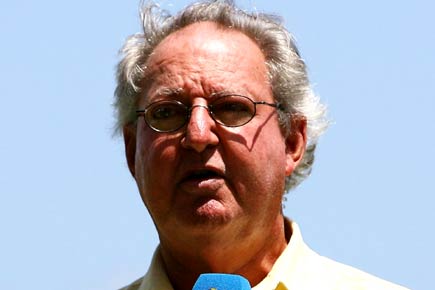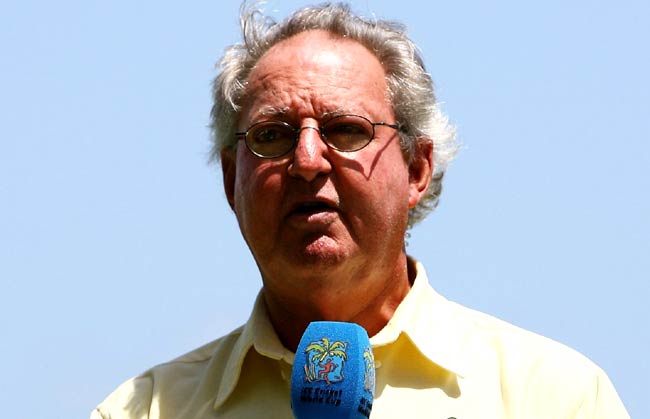It is a strange irony that the timing of international television coverage out of the Caribbean effectively eliminates the West Indies from the increasing move towards Test cricket under lights at the same time as it obliges the Caribbean Premier League (CPL) Twenty20 tournament to revert to daytime for all but four of its 31 matches in its second season that got underway recently

Tony Cozier
It is a strange irony that the timing of international television coverage out of the Caribbean effectively eliminates the West Indies from the increasing move towards Test cricket under lights at the same time as it obliges the Caribbean Premier League (CPL) Twenty20 tournament to revert to daytime for all but four of its 31 matches in its second season that got underway recently.
Tony Cozier
It appears that only the t-s are to be crossed and the i-s dotted for the first night Test in November 2015 between Australia and New Zealand, either in Adelaide or Hobart.
ADVERTISEMENT
It could be the game's latest lasting innovation to follow those of Kerry Packer's World Series Cricket (WSC), which introduced its own night 'Supertests' as far back as 1979, and Lalit Modi's Indian Premier League (IPL).
The purpose is to reverse the decline in attendances causing concern over the survival of the traditional, unadulterated form of the game against its newest, trendiest offshoot, Twenty20.
The theory is that play from 2 pm to 9 pm would allow the public to take in most of the last two sessions after office hours.
The pink ball will be used. It has been tested under lights in recent years in first-class matches in the West Indies, Australia and between English county teams in the Emirates. Not all the players, least for all the Australians, are in favour but the boards regard it as a fait accompli.
Whether the experiment – for that is what it would be – is permanent or not, it won't involve Tests in the Caribbean. The regional cricket centres are far enough to the west of the other countries that live television would be delivered at inhospitable hours.
A local 9 pm close of play would be one or two in the morning in England, an hour later in South Africa. Indians would have to watch from 10.30 pm to 5.30 next morning. A 10 am-5 pm day equates to 2 or 3 pm-9 or 10 pm in the UK, ideal scheduling.
It's the reason why the West Indies have staged no more than a couple of ODIs under lights and none for a decade. Even matches in the 2007 World Cup and the 2012 World Twenty20 were daylight encounters.
For the recent three Tests against New Zealand, the West Indies Cricket Board (WICB) attempted to boost attendances by appreciably lowering ticket prices; by the time the series got to Barbados for the decider, US$5 was the most expensive.
Here was a contest between evenly-matched national teams jostling for positions in the ICC rankings. It featured fascinating fluctuations from one match to the next, one day to the next, one session to the next before New Zealand secured their 2-1 triumph nearing the end of the final day of the series.
Only matches over five days without artificial restrictions can offer such ebb and flow.
It might have been enough to give a bit of a boost to the public's waning interest. Instead, there was rarely more than a couple of thousand in the stands, for the five days at Queen's Park (capacity 22,000), about as many as would once turn out for a club match.
While certain extenuating circumstances existed in this case - the simultaneous attraction of the omnipresent football World Cup, West Indies' dismal recent record, the lack of star players on either side - Tests everywhere, England excepted, have long since failed the 'bums-on-seats' test.
The floodlit proposal is the obvious corollary. In a recent column in The Times, the former England captain Mike Atherton reckoned night Tests were "worth a try, surely".
"No one is suggesting day/night Test cricket should be played in England but imagine a Test match in Bridgetown, Barbados, for example," he wrote.
"The last session of play could be played on a warm evening, with light falling quickly, and cheap tickets for the final session could encourage the working man in Bridgetown to pop in for a couple of hours to enjoy something he might not otherwise have a chance to see."
It is an agreeable image except it won't happen for the same reason the CPL has had to alter its times.
The staging of its matches with the lowering temperature of the evenings, when fans were free of their 9-to-5 jobs, guaranteed sell-out crowds at all six CPL venues last year.
The lights meshed perfectly with the carnival atmosphere typical of the Caribbean and its slogan, "the biggest party in sport". Calypso rhythms, fireworks and dancing girls were added to the mix that made it a rousing success.
It'll have a different feel over the coming six weeks of the second season. With a new contract with BT Sport television channels in England to be considered, it made the adjustment.
After all, television contracts are the main revenue earners as much for the CPL as for the WICB.
In the circumstances, the CPL launched a regional twitter petition "calling on businesses and governments across the region to let employees leave work early to watch the mid-week CPL game in their respective countries".
The petition, it stated, "is a rallying cry to cricket fans and party people alike to fight for their right to enjoy the 'biggest party in sport'". It ignored the economic realities that have forced most of the vulnerabe mini-states of the Caribbean to cut public service jobs and adopt IMF-induced austerity measures.
"The biggest party in sport" takes in two new islands in 2014. Bouyed by University of the West Indies (UWI) research that put the CPL's combined impact at US$105.6 million in the countries where it was played in 2013, the Grenada government reportedly paid US$500,000 for the first three matches to be staged at its National Stadium; the St.Kitts-Nevis government is said to have spent US$1 million to hold nine matches, including semi-finals and final, at Windsor Park in Basseterre.
They clearly regard it as a worthy investment regardless of the timing of the tv coverage.
 Subscribe today by clicking the link and stay updated with the latest news!" Click here!
Subscribe today by clicking the link and stay updated with the latest news!" Click here!







